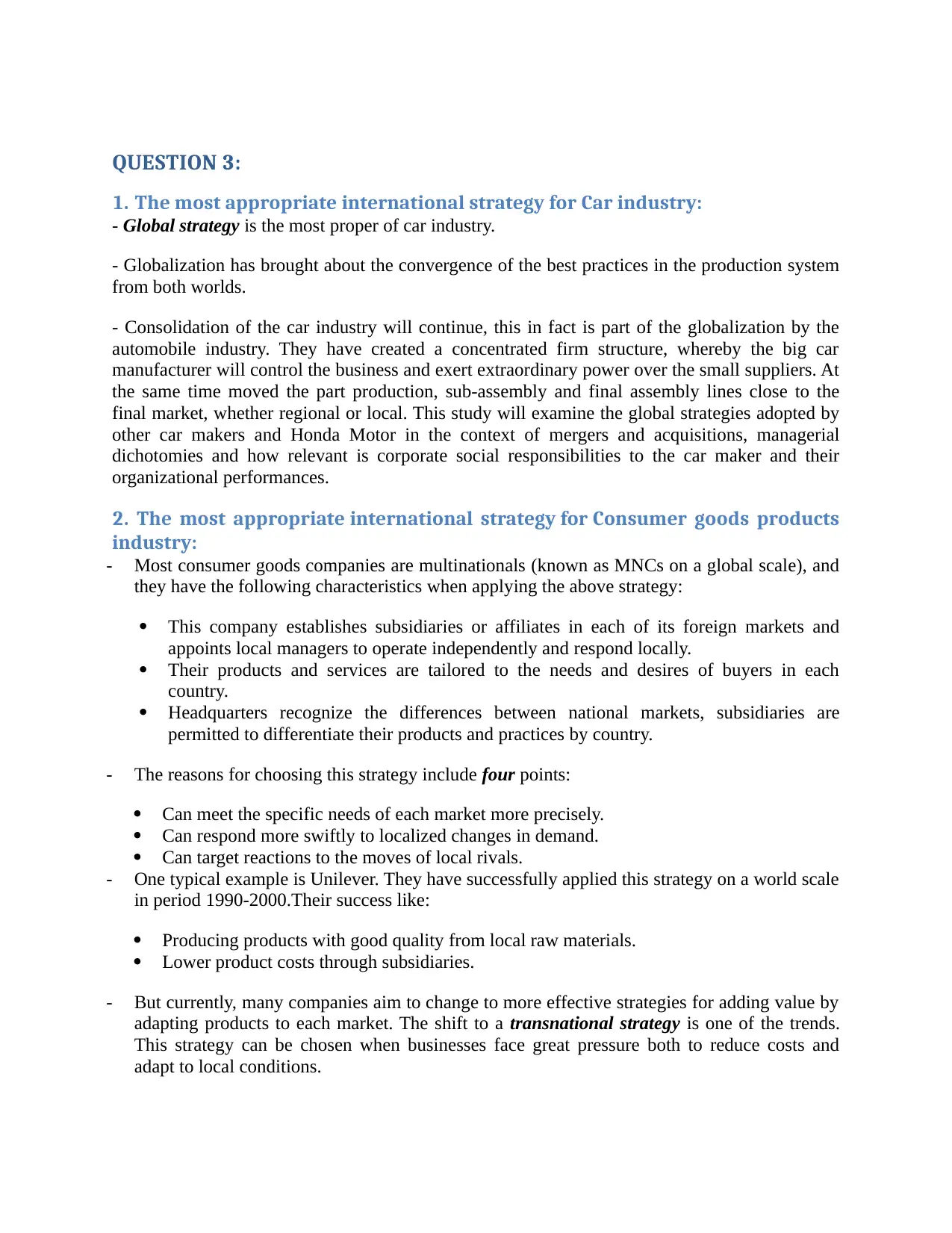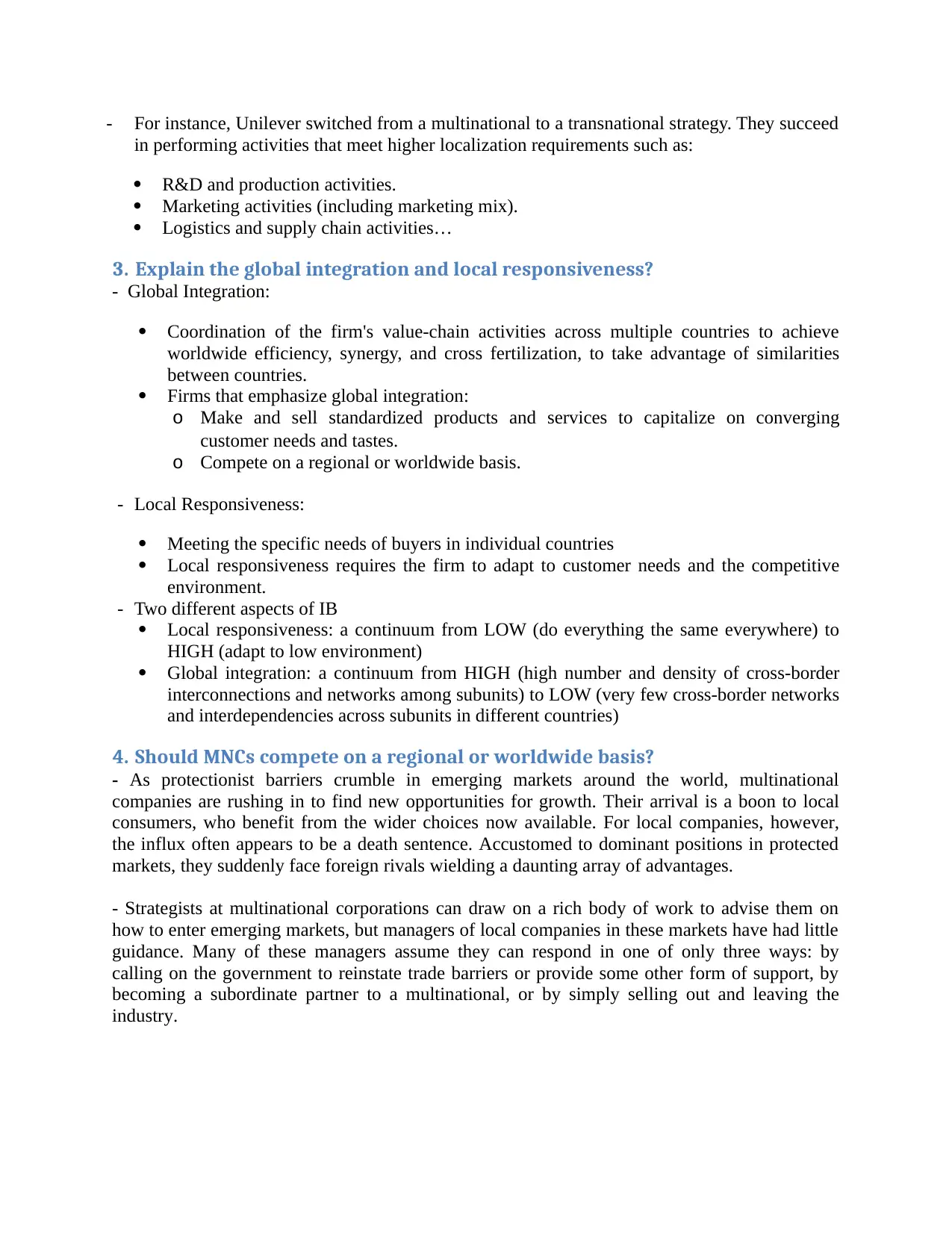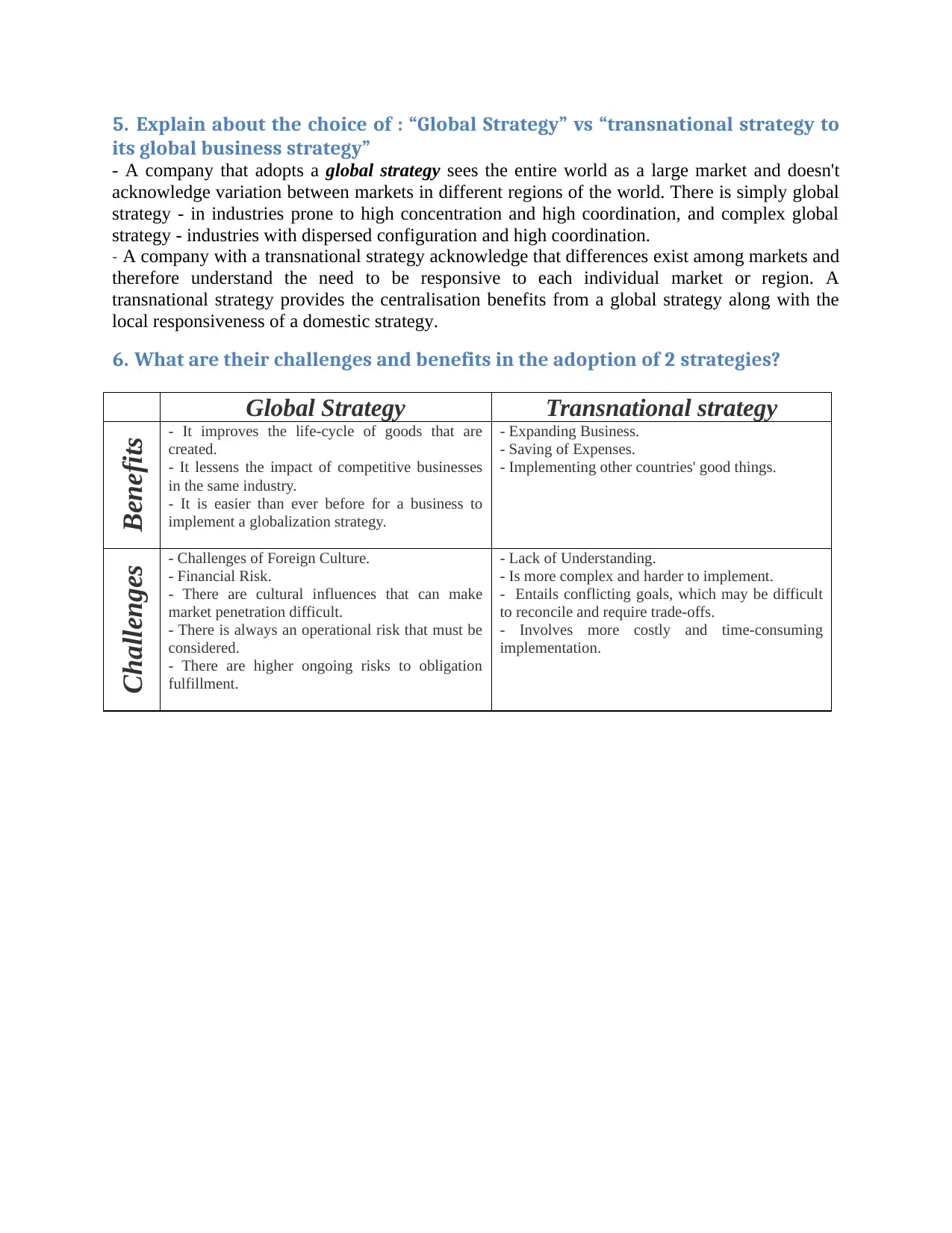Global Strategy vs Transnational Strategy in Global Business
VerifiedAdded on 2022/10/20
|3
|1066
|36
Essay
AI Summary
This essay examines the application of global and transnational strategies in international business, particularly within the car and consumer goods industries. It argues that a global strategy is most suitable for the car industry due to globalization and the convergence of best practices, while a transnational strategy is more appropriate for consumer goods companies needing to balance cost reduction and local adaptation. The essay discusses the concepts of global integration and local responsiveness, evaluating whether multinational corporations (MNCs) should compete regionally or worldwide. It further contrasts global and transnational strategies, highlighting their respective benefits and challenges, such as improved product lifecycles versus cultural complexities and conflicting goals.

QUESTION 3:
1. The most appropriate international strategy for Car industry:
- Global strategy is the most proper of car industry.
- Globalization has brought about the convergence of the best practices in the production system
from both worlds.
- Consolidation of the car industry will continue, this in fact is part of the globalization by the
automobile industry. They have created a concentrated firm structure, whereby the big car
manufacturer will control the business and exert extraordinary power over the small suppliers. At
the same time moved the part production, sub-assembly and final assembly lines close to the
final market, whether regional or local. This study will examine the global strategies adopted by
other car makers and Honda Motor in the context of mergers and acquisitions, managerial
dichotomies and how relevant is corporate social responsibilities to the car maker and their
organizational performances.
2. The most appropriate international strategy for Consumer goods products
industry:
- Most consumer goods companies are multinationals (known as MNCs on a global scale), and
they have the following characteristics when applying the above strategy:
This company establishes subsidiaries or affiliates in each of its foreign markets and
appoints local managers to operate independently and respond locally.
Their products and services are tailored to the needs and desires of buyers in each
country.
Headquarters recognize the differences between national markets, subsidiaries are
permitted to differentiate their products and practices by country.
- The reasons for choosing this strategy include four points:
Can meet the specific needs of each market more precisely.
Can respond more swiftly to localized changes in demand.
Can target reactions to the moves of local rivals.
- One typical example is Unilever. They have successfully applied this strategy on a world scale
in period 1990-2000.Their success like:
Producing products with good quality from local raw materials.
Lower product costs through subsidiaries.
- But currently, many companies aim to change to more effective strategies for adding value by
adapting products to each market. The shift to a transnational strategy is one of the trends.
This strategy can be chosen when businesses face great pressure both to reduce costs and
adapt to local conditions.
1. The most appropriate international strategy for Car industry:
- Global strategy is the most proper of car industry.
- Globalization has brought about the convergence of the best practices in the production system
from both worlds.
- Consolidation of the car industry will continue, this in fact is part of the globalization by the
automobile industry. They have created a concentrated firm structure, whereby the big car
manufacturer will control the business and exert extraordinary power over the small suppliers. At
the same time moved the part production, sub-assembly and final assembly lines close to the
final market, whether regional or local. This study will examine the global strategies adopted by
other car makers and Honda Motor in the context of mergers and acquisitions, managerial
dichotomies and how relevant is corporate social responsibilities to the car maker and their
organizational performances.
2. The most appropriate international strategy for Consumer goods products
industry:
- Most consumer goods companies are multinationals (known as MNCs on a global scale), and
they have the following characteristics when applying the above strategy:
This company establishes subsidiaries or affiliates in each of its foreign markets and
appoints local managers to operate independently and respond locally.
Their products and services are tailored to the needs and desires of buyers in each
country.
Headquarters recognize the differences between national markets, subsidiaries are
permitted to differentiate their products and practices by country.
- The reasons for choosing this strategy include four points:
Can meet the specific needs of each market more precisely.
Can respond more swiftly to localized changes in demand.
Can target reactions to the moves of local rivals.
- One typical example is Unilever. They have successfully applied this strategy on a world scale
in period 1990-2000.Their success like:
Producing products with good quality from local raw materials.
Lower product costs through subsidiaries.
- But currently, many companies aim to change to more effective strategies for adding value by
adapting products to each market. The shift to a transnational strategy is one of the trends.
This strategy can be chosen when businesses face great pressure both to reduce costs and
adapt to local conditions.
Paraphrase This Document
Need a fresh take? Get an instant paraphrase of this document with our AI Paraphraser

- For instance, Unilever switched from a multinational to a transnational strategy. They succeed
in performing activities that meet higher localization requirements such as:
R&D and production activities.
Marketing activities (including marketing mix).
Logistics and supply chain activities…
3. Explain the global integration and local responsiveness?
- Global Integration:
Coordination of the firm's value-chain activities across multiple countries to achieve
worldwide efficiency, synergy, and cross fertilization, to take advantage of similarities
between countries.
Firms that emphasize global integration:
o Make and sell standardized products and services to capitalize on converging
customer needs and tastes.
o Compete on a regional or worldwide basis.
- Local Responsiveness:
Meeting the specific needs of buyers in individual countries
Local responsiveness requires the firm to adapt to customer needs and the competitive
environment.
- Two different aspects of IB
Local responsiveness: a continuum from LOW (do everything the same everywhere) to
HIGH (adapt to low environment)
Global integration: a continuum from HIGH (high number and density of cross-border
interconnections and networks among subunits) to LOW (very few cross-border networks
and interdependencies across subunits in different countries)
4. Should MNCs compete on a regional or worldwide basis?
- As protectionist barriers crumble in emerging markets around the world, multinational
companies are rushing in to find new opportunities for growth. Their arrival is a boon to local
consumers, who benefit from the wider choices now available. For local companies, however,
the influx often appears to be a death sentence. Accustomed to dominant positions in protected
markets, they suddenly face foreign rivals wielding a daunting array of advantages.
- Strategists at multinational corporations can draw on a rich body of work to advise them on
how to enter emerging markets, but managers of local companies in these markets have had little
guidance. Many of these managers assume they can respond in one of only three ways: by
calling on the government to reinstate trade barriers or provide some other form of support, by
becoming a subordinate partner to a multinational, or by simply selling out and leaving the
industry.
in performing activities that meet higher localization requirements such as:
R&D and production activities.
Marketing activities (including marketing mix).
Logistics and supply chain activities…
3. Explain the global integration and local responsiveness?
- Global Integration:
Coordination of the firm's value-chain activities across multiple countries to achieve
worldwide efficiency, synergy, and cross fertilization, to take advantage of similarities
between countries.
Firms that emphasize global integration:
o Make and sell standardized products and services to capitalize on converging
customer needs and tastes.
o Compete on a regional or worldwide basis.
- Local Responsiveness:
Meeting the specific needs of buyers in individual countries
Local responsiveness requires the firm to adapt to customer needs and the competitive
environment.
- Two different aspects of IB
Local responsiveness: a continuum from LOW (do everything the same everywhere) to
HIGH (adapt to low environment)
Global integration: a continuum from HIGH (high number and density of cross-border
interconnections and networks among subunits) to LOW (very few cross-border networks
and interdependencies across subunits in different countries)
4. Should MNCs compete on a regional or worldwide basis?
- As protectionist barriers crumble in emerging markets around the world, multinational
companies are rushing in to find new opportunities for growth. Their arrival is a boon to local
consumers, who benefit from the wider choices now available. For local companies, however,
the influx often appears to be a death sentence. Accustomed to dominant positions in protected
markets, they suddenly face foreign rivals wielding a daunting array of advantages.
- Strategists at multinational corporations can draw on a rich body of work to advise them on
how to enter emerging markets, but managers of local companies in these markets have had little
guidance. Many of these managers assume they can respond in one of only three ways: by
calling on the government to reinstate trade barriers or provide some other form of support, by
becoming a subordinate partner to a multinational, or by simply selling out and leaving the
industry.

5. Explain about the choice of : “Global Strategy” vs “transnational strategy to
its global business strategy”
- A company that adopts a global strategy sees the entire world as a large market and doesn't
acknowledge variation between markets in different regions of the world. There is simply global
strategy - in industries prone to high concentration and high coordination, and complex global
strategy - industries with dispersed configuration and high coordination.
- A company with a transnational strategy acknowledge that differences exist among markets and
therefore understand the need to be responsive to each individual market or region. A
transnational strategy provides the centralisation benefits from a global strategy along with the
local responsiveness of a domestic strategy.
6. What are their challenges and benefits in the adoption of 2 strategies?
Global Strategy Transnational strategy
Benefits - It improves the life-cycle of goods that are
created.
- It lessens the impact of competitive businesses
in the same industry.
- It is easier than ever before for a business to
implement a globalization strategy.
- Expanding Business.
- Saving of Expenses.
- Implementing other countries' good things.
Challenges - Challenges of Foreign Culture.
- Financial Risk.
- There are cultural influences that can make
market penetration difficult.
- There is always an operational risk that must be
considered.
- There are higher ongoing risks to obligation
fulfillment.
- Lack of Understanding.
- Is more complex and harder to implement.
- Entails conflicting goals, which may be difficult
to reconcile and require trade-offs.
- Involves more costly and time-consuming
implementation.
its global business strategy”
- A company that adopts a global strategy sees the entire world as a large market and doesn't
acknowledge variation between markets in different regions of the world. There is simply global
strategy - in industries prone to high concentration and high coordination, and complex global
strategy - industries with dispersed configuration and high coordination.
- A company with a transnational strategy acknowledge that differences exist among markets and
therefore understand the need to be responsive to each individual market or region. A
transnational strategy provides the centralisation benefits from a global strategy along with the
local responsiveness of a domestic strategy.
6. What are their challenges and benefits in the adoption of 2 strategies?
Global Strategy Transnational strategy
Benefits - It improves the life-cycle of goods that are
created.
- It lessens the impact of competitive businesses
in the same industry.
- It is easier than ever before for a business to
implement a globalization strategy.
- Expanding Business.
- Saving of Expenses.
- Implementing other countries' good things.
Challenges - Challenges of Foreign Culture.
- Financial Risk.
- There are cultural influences that can make
market penetration difficult.
- There is always an operational risk that must be
considered.
- There are higher ongoing risks to obligation
fulfillment.
- Lack of Understanding.
- Is more complex and harder to implement.
- Entails conflicting goals, which may be difficult
to reconcile and require trade-offs.
- Involves more costly and time-consuming
implementation.
⊘ This is a preview!⊘
Do you want full access?
Subscribe today to unlock all pages.

Trusted by 1+ million students worldwide
1 out of 3
Related Documents
Your All-in-One AI-Powered Toolkit for Academic Success.
+13062052269
info@desklib.com
Available 24*7 on WhatsApp / Email
![[object Object]](/_next/static/media/star-bottom.7253800d.svg)
Unlock your academic potential
Copyright © 2020–2025 A2Z Services. All Rights Reserved. Developed and managed by ZUCOL.





